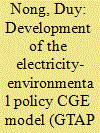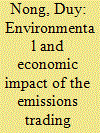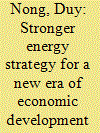|
|
|
Sort Order |
|
|
|
Items / Page
|
|
|
|
|
|
|
| Srl | Item |
| 1 |
ID:
176763


|
|
|
|
|
| Summary/Abstract |
A new carbon price mechanism with full emission coverage is developed within the framework of a global computable general equilibrium model (GTAP-E-PowerS) to enhance the capacity and accuracy for climate change and energy policy assessment. The model developed is then used to examine the potential impacts of the carbon tax in South Africa. Results show that incorporation of non-CO2 emissions in the model significantly alters the results of which the economy of South Africa experiences higher costs compared to the case that only has CO2 emissions. When more sectors are included in the policy it also puts higher costs on the economy, as higher levels of emissions are subject to the carbon tax. Results also show that South Africa only experiences small tradeoffs from introducing the carbon tax in all scenarios. That is, with a tax rate of $9.15, the country is able to reduce its emission levels by 12.25%–15.6% at the costs of real GDP reduction by 1.17%–1.59%. Fossil-based industrial sectors are particularly worst off, while clean and renewable energy sectors strongly expand their production. The results indicate that South Africa is likely to move to a low carbon and sustainable economy with such a policy.
|
|
|
|
|
|
|
|
|
|
|
|
|
|
|
|
| 2 |
ID:
176764


|
|
|
|
|
| Summary/Abstract |
This study aims to fill a gap in the literature by examining the impacts of an emissions trading scheme (ETS) in Vietnam, as the policy has been discussed for a decade in the country but the likely impacts on the economy and different sectors are still unidentified. The simulations are carried out in a global energy computable general equilibrium (CGE) model, an extension of the GTAP-E model, which treats Vietnam as a country region. Results show that restricting the number of industrial sectors in the emissions trading market substantially affects the country's economy with a decline in real GDP by 4.57%. However, the country experiences much smaller adverse impacts (e.g., real GDP declines by 1.78%) when all industries participate in the emissions trading market. In either case of the ETS design, the coal mining, manufacturing, transportation, and electricity sectors are highly adversely affected; however, the crude oil and natural gas extraction sectors would experience expansion in their production levels due to substitutions for coal. In general, under the policy the emission levels from burning fossil fuels decline at significant rates, particularly from the electricity generation sector.
|
|
|
|
|
|
|
|
|
|
|
|
|
|
|
|
| 3 |
ID:
162272


|
|
|
|
|
| Summary/Abstract |
The Vietnamese Government is proposing a new tax levy on either petroleum products or coal, or both. That is, the Government expects to increase the current tax rates to the maximum levels set previously. In this instance, the tax on coal is intended to increase by 50%, while the tax on petroleum products is intended to increase by 33.33%. This study employs a computable general equilibrium model to assess the effects of these increases in taxes on the Vietnamese economy, focusing on energy, transportation, and the private sectors. Results show that an increase in tax on petroleum products will considerably affect the country with a reduction of real GDP by 1.99%. Exports and imports are also highly unfavorably affected. In this instance, the total emission level will be reduced by 7.12%. The increased tax on coal, however, will allow Vietnam to experience much lower unfavorable effects, while being able to cut a substantial amount of the emission level. For example, real GDP would only decline by 0.51%, while total emission level will be reduced by 10.25%. If these taxes are increased together, Vietnam will experience considerable contractions in the economy, but it is able to reduce a substantial emission level.
|
|
|
|
|
|
|
|
|
|
|
|
|
|
|
|
| 4 |
ID:
176858


|
|
|
|
|
| Summary/Abstract |
Energy security has been a major concern in developing countries because of rapid economic development and population growth, low power generation capacity, and unwell-developed transmission infrastructure. Vietnam in this context has been under energy security threats for more than a decade and is currently having a new power policy to strongly develop power generation and distribution networks. It is expected that the country's economy is able to develop substantially due to massively additional energy supply once completing the plants and distribution networks but the likely impacts are still undefined. This paper extends an economic electricity-detailed model to examine the potential impacts of such a new power policy in Vietnam. We find that the policy will decrease the prices of both fossil-based and renewable-based electricity significantly by 40%–78% under a 2030 target scenario, benefiting all sectors in the economy to substitute for fossil fuels. Households are particularly benefited as evidenced by 5.64%–19.19% increases in per-capita utility. Overall, the Vietnamese economy is significantly advantaged with real GDP increasing by 5.44%–24.83% over different scenarios, which are much higher than the findings in other countries. More importantly, the policy moves the country to a low-carbon energy structure in the near future.
|
|
|
|
|
|
|
|
|
|
|
|
|
|
|
|
|
|
|
|
|